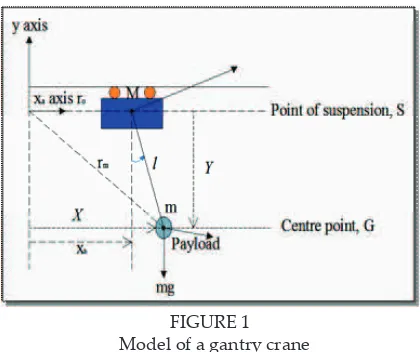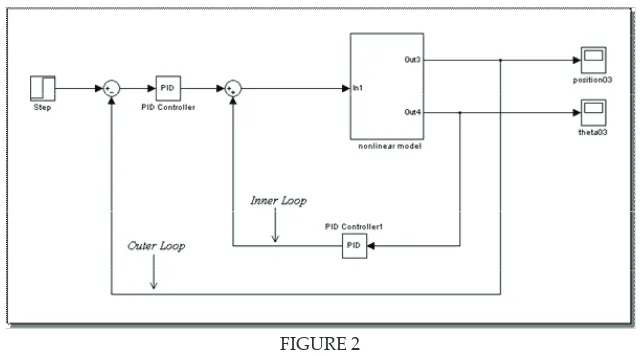ISSN: 2180-1053 Vol. 1 No. 1 July-December 2009 63
VIBRATION CONTROL OF A GANTRY CRANE SYSTEM USING
DYNAMIC FEEDBACK SWING CONTROLLER
Azdiana
1, Noor Asyikin
1, Sharatul Izah
1, Nur Alisa
11
Faculty of Electronics Engineering and Computer Engineering,
Universiti Teknikal Malaysia Melaka, Locked Bag 1752,
Pejabat Pos Durian Tunggal, 76109 Durian Tunggal, Melaka.
ABSTRACTThe use of gantry crane system for transporting payload is very common in industrial application. However, moving the payload using the crane is not easy task especially when strict speciications on the swing angle and on the transfer time need to be satisied. To overcome this problem a dynamic feedback swing controller is designed for the gantry position and speed, as well as the load angle and angular velocity using PID controller. Simulated responses of the position of the trolley and sway angle of the mass are presented using MATLAB. The performance of the Bang-bang torque input function and the feedback swing controller are compared. From the simulation results, satisfactory vibration reduction of a crane system has been achieved using the proposed method.
KEYWORDS: PID controller, Dynamic feedback swing controller, gantry crane system
1.0
INTRODUCTION
A gantry crane system is a crane carrying the trolley or trolley with a movable or ixed hoisting mechanism, that the bridge is rigidly supported on two or more legs running on ixed rails or other runway. The fundamental motions of a gantry crane consist of traversing, load hosting and load lowering. Like other crane types, gantry cranes met with some dissatisfactory due to its natural characteristics. Nowadays, industrial uses gantry crane to transfer the loads but not too safety because of the load always swing and might be any incident occurs. The operator, by skillful manual drive of the gantry controls, ensures that this unavoidable pendulum motion subsides as quickly as possible, since extended loading and unloading time costly.
Increasingly however, feedback control which is well known to be less sensitive to disturbances and parameter variations also adopted to control the gantry crane system. Work that has been presented by Omar [H.M. Omar, 2003] had proposed PD (Proportional-Derivative) controllers for both position and anti-swing controls. Moreover, a Fuzzy Logic Controller had been introduced by Wahyudi and Jamaludin [Wahyudi and J. Jalani, 2005]. Fuzzy logic controllers were designed and implemented for controlling payload position as well as the swing angle of the gantry crane.
This paper will focus on a feedback control system based on the dynamic model of the gantry crane system. The main idea is to produce vibration free system using PID as a controller algorithm. The improvement of the output response will be investigated by comparing the dynamic feedback swing controller and bang-bang torque input function.
2.0 MODELLING OF A GANTRY CRANE SYSTEM
This section will emphasize on the modelling of a gantry crane that includes
ISSN: 2180-1053 Vol. 1 No. 1 July-December 2009 65
FIGURE 1
Model of a gantry crane
Before the derivation of the equations of motion, some assumptions are made for simplicity. Firstly, friction force that may exist in the trolley is ignored. The trolley and the payload can be considered as point masses. Besides, the tension force that may cause the hoisting rope elongate is also neglected. The trolley and the payload are assumed to move in x-y plane, which means a study of two dimensional.
For the dynamic behaviors of the gantry crane model, the centre point G and the position vector of point of suspension, S with respected to the ixed axes coordinate have to be determined.
The position of the load is given by:
Based on the above assumptions, the equations of motion for the gantry crane system depicted in Figure 1 are derived as follows.
Ater linearization, then equation of motion of the gantry crane becomes:
achieves a stable system. Gains are determined to complete this feedback for gantry crane system.
Whereas, swing control refers to payload that carried by the trolley. The trolley is controlled with feedback system to ensure minimal swing of payload. This method able to control the swing of payload until the trolley reaches target position without vibration. By conclusion, dynamic feedback swing control means the trolley moves along the track with internal forces and external forces from the initial generation of the feedback signal to the subsequent modiication of the system by controlling the swing of payload to reduce vibration.
Dynamic feedback swing control is a method used to drive a system of gantry crane uncertain mass from initial position to a target position as quickly, accurately and safely as possible without vibration by reducing the sway angle of payload. This dynamic feedback is designed by using PID controller. The value of certain system parameters such as rope length and payload mass may signiicantly during the operation. This project will focus on closed loop control system where a dynamic model is designed by using SIMULINK in the MATLAB sotware. It will be analyzed by referring to the derivation of the dynamic feedback input function.
The irst step to design PID controller is to determine the type of controller whether SISO type or MIMO type. SISO type also known as Single Input Single Output while MIMO is known as Multiple Input Multiple Output. Based on the plant of gantry crane, two forces are needed to move the trolley until it reach target position (1 meter) without vibration. It means two inputs and two outputs are considered in order to reduce the vibration. So, this cascade PID controller design is called as MIMO type controller.
ISSN: 2180-1053 Vol. 1 No. 1 July-December 2009 67
FIGURE 2 Inner loop and outer loop
Both outputs can be controlled by using PID tuning based on process response. When a process response rapidly change in the manipulate variable, tuning can be determined by observing the response to change in controller parameters. In general the parameters are tuned in order proportional (Kp), integral (Ti), derivative (Td). Each parameter is increased until a sustained oscillation is observed in process variable response.
4.0
RESULTS AND ANALYSIS
In this work, the following gantry crane parameters are used. The parameters correspond to the experimental crane system presented by Yong-Seok Kim, Han-suk Seo and Seung-Ki in [Y.S. Kim et al., 2001]. System.
i. Trolley mass, M=1 kg
ii. Payload mass, m=0.8 kg
iii. Length of the hoisting rope, l=0.305 meter
A comparison with input shaping technique has been executed in order to prove the efectiveness of the approach presented in this paper. The dynamic feedback swing controller has been compared with the bang-bang torque input function that is assumed to be 1.8 Nm.
From the following simulation results in Figure 6, which the bang-bang torque input function is applied to the trolley, it can be seen that the sway angle in radian have a trend related to the applied force directions. However, when the applied force is taken of (Fx = 0N), it is found that the load still oscillate and is having a large oscillation. This result indicates that the payload motion has a very signiicant response to acceleration or deceleration commands without any feedback control.
It is noted that the motion of the payload is afected by the applied force which it will swing according to its path deined earlier. In bang-bang torque input function, the payload continues to oscillate although the force is taken of by the time 2 seconds. The payload oscillates with a maximum value 0.28 radian, which is approximately 16.04 degree from its initial position. This value is become signiicant when the length of hoisting rope become larger. This is due to the chord length, which is nearly equal to the arc length that proportionally increases with the length of the hoisting rope as illustrated in Figure 5.
FIGURE 5
ISSN: 2180-1053 Vol. 1 No. 1 July-December 2009 69
FIGURE 6
Payload sway angle by using bang-bang torque input function
Thus, from the simulation result in Figure 6, the 0.28 radian will create a 8.4 cm chord length, which is considered as a large swing in this case. For industrial use gantry crane, this will cause nearly 1 meter chord length which will create safety problems and damages to the surrounding environment.
Hence, by using dynamic feedback swing controller adopted in Figure 7, the payload stops oscillate with no vibration. It will not create any chord length, resulting the vibration reduction of sway angle in this technique is 100% compared to bang-bang torque input function. Table 1 shows the summary results of the sway angle of the payload by using both techniques.
FIGURE 7
Payload sway angle by using dynamic feedback swing controller
TABLE 1
Sway Angle of the Hoisting Rope
FIGURE 8
Trolley positioning by using bang-bang torque input function
FIGURE 9
Trolley positioning by using dynamic feedback swing controller
The time response of the trolley position has been simpliied in Table 2. Although the setling time and rise time of bang-bang torque input function is faster than dynamic feedback swing controller, in terms of vibrations, the performance of dynamic feedback swing controller is beter than bang-bang input force.
TABLE 2
ISSN: 2180-1053 Vol. 1 No. 1 July-December 2009 71
This research is inancially supported by CRIM, Universiti Teknikal Malaysia Melaka.
7.0
REFERENCES
A. Piazzi, and A. Visioli. 2000. Minimum Time System Inversion-Based Motion Planning for Residual Vibration Reduction. IEEE/ASME Trans. Mechatronics, pp. 12-22.
D.W. Frakes. 2001. Input-Shaped Control of Gantry Cranes: Simulation and Curriculum Developmen. Proceedings of the Eighteenth ASME Biennial Conference on Mechanical Vibration and Noise.
G.A. Manson.1992.Time-optimal control of an overhead crane model. Optimal Control Applications & Methods, Vol. 3, No. 2, pp.115-120.
H.M. Omar. 2003. Control of Gantry and Tower Cranes. Ph.D. Thesis. M.S. Virginia Tec. 12-25.
J.K. Cho and Y.S. Park. 1995. Vibration reduction in lexible systems using a time-varying impulse sequence. Robotica, 13, pp. 305-313.
M. Kenison. and W. Singhose. 1999. Input Shaper Design for Double-Pendulum Planar Gantry Cranes. Control Applications, pp. 539-544; 1999.
M. N Sahinkaya. 2001. Input Shaping for vibration-free positioning of lexible systems. Proceedings of Institution Mechanical Engineers, Vol 215, pp. 467-481.
Wahyudi and J. Jalani. 2005. Design and Implementation of Fuzzy Logic Controller for an Intelligent Gantry Crane System. Proceedings of the 2nd International Conference on Mechatronics, pp. 345-351.
Wildi and Theodore. 2000. Electrical Machines, Drives and Power Systems. Fourth edition. Prentice-Hall Inc. 417-433; 2000.




